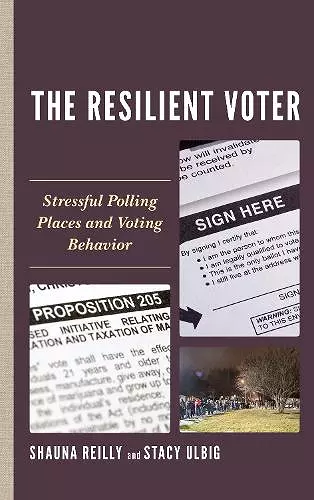The Resilient Voter
Stressful Polling Places and Voting Behavior
Shauna Reilly author Stacy G Ulbig author
Format:Paperback
Publisher:Lexington Books
Published:28th Oct '19
Currently unavailable, and unfortunately no date known when it will be back
This paperback is available in another edition too:
- Hardback£90.00(9781498533522)

The Resilient Voter: Stressful Polling Places and Voting Behavior provides a new perspective on the role voting barriers play, demonstrating that they not only discourage participation but also affect the quality of votes cast. Offering an interesting and unique approach to the study of voting barriers, Shauna Reilly and Stacy G. Ulbig investigate the possibility that complicated ballot language, provisional voting, and long polling place lines cause some voters to cast ballots in a manner contradictory to their preferences. Building on arguments that stressful polling place conditions subject citizens to stress that can prevent them from casting complete ballots or even choosing to vote at all, the authors ask whether those who endure polling place frustrations and persevere to cast a ballot might become so stressed by their experience that they are unable to mark their ballots in a manner consistent with their standing policy preferences. Using a creative experimental design, the authors examine the ways in which complex ballot language, registration difficulties, and long polling place lines affect voters’ stress levels, and how such anxieties translate into the willingness to cast a complete ballot and the ability to vote in a manner conforming to previously expressed preferences. The authors demonstrate that even though most voters prove remarkably resilient in the face of some potentially stressful polling place barriers, they are not immune to all polling place conditions. Further, they illustrate that some segments of the electorate tend to be more vulnerable to polling place stressors than others and illustrate the ways in which the compound effects of multiple barriers can exert an even wider impact.
Reilly (Northern Kentucky Univ.) and Ulbig (Sam Houston State) hypothesize that stress introduced into the voting process can have negative consequences for voters, causing some to decline to complete their ballots or to vote in ways inconsistent with their true policy preferences. Compelling introductions to each chapter pull from recent events covered in the news media and in previous research. The new contribution is data from a mock election experiment conducted at a large undergraduate university, with participants randomly assigned to having to wait to cast their ballots or being challenged at the polling place and directed to complete a provisional ballot. Prior to voting, participants completed a survey indicating their preferences on various issues; those issues were then incorporated into constitutional amendment ballot items on marijuana, abortion, and same-sex marriage. The estimated effect sizes are small and rarely statistically significant. Provisional ballots and long, arbitrary, and unexplained wait times do not seem to make voters more stressed or less able to express their preferences at the polls (at least in this one experiment). Further research is needed, but if the findings hold, this is good news for those who face adversity at the polls. Summing Up: Recommended. Graduate students through faculty. * CHOICE *
Reilly and Ulbig have produced a novel study on the impact of stressful polling place conditions on voters. They identify several areas where the voting process can be improved. -- David Kimball, University of Missouri–St. Louis
Reilly and Ulbig creatively combine literature on “correct voting,” election administration, and stress. They present well-crafted evidence that “polling place pandemonium” causes stress that affects a voters’ ability to vote consistently with policy preference. This work advances convincing evidence that polling place problems are stressful and make it tough to vote “correctly.” Reilly and Ulbig show why it is so important to improve polling place processes and provide strong research that adds to the importance of making voting as smooth as possible on Election Day. Both scholars and election administrators should absolutely read this book. -- Martha Kropf, University of North Carolina, Charlotte
Most prior works focus exclusively on variables that shape turnout or whether or not an individual will show up to vote on Election Day. . . . We need more works like The Resilient Voter, where the focus is not upon whether an individual turns out to vote but rather what happens to that voter between the time that the voter shows up to the polls on Election Day and when the final ballot is cast. * Public Opinion Quarterly *
ISBN: 9781498533546
Dimensions: 222mm x 151mm x 12mm
Weight: 308g
192 pages